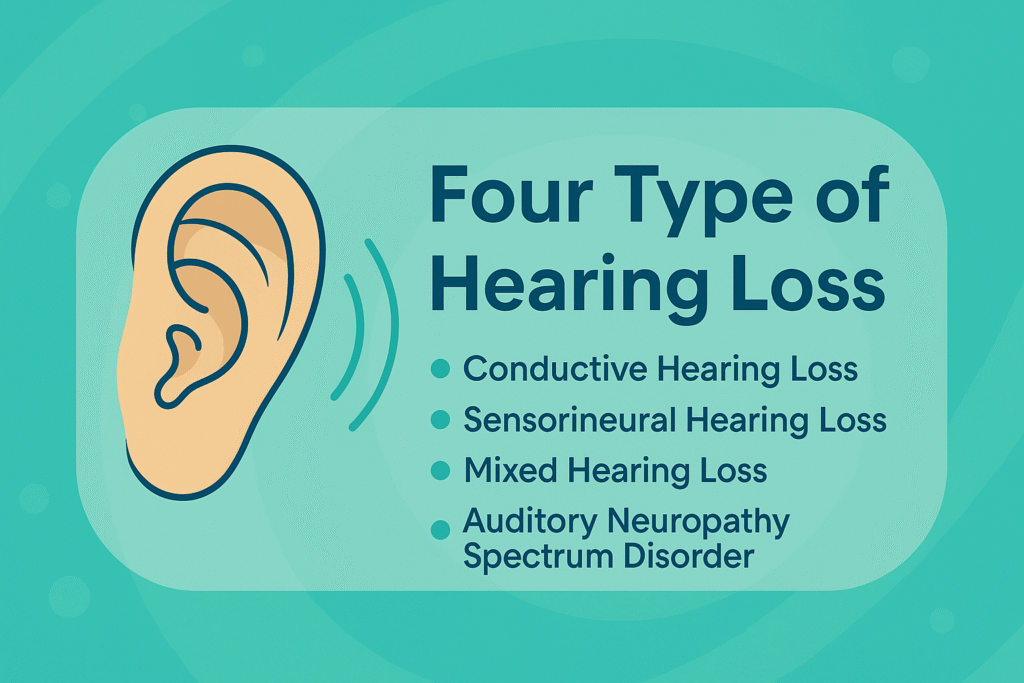
All Types of Hearing Loss Explained Comprehensive Guide
Hearing loss( also known as hearing impairment) is a wide condition affecting people of all periods worldwide. Learn further about each type of hearing loss for early discovery, opinion, and treatment. This companion will explore the differents hearing loss type, common causes and symptoms and popular treatments so you or your loved bones
can take the correct step toward better hearing.
Understanding various hearing loss types
There are substantially four types of hearing loss, each with different traits and reasons behind them. These include :
1. Conductive Hearing Loss
Happens when sound swells can not duly reach the inner observance because of blockages or damage in the observance conduit or middle observance.
Common Causes
- Ear Infections: Fluid buildup in the middle ear can impede sound transmission.
- Earwax Buildup: A simple yet common cause of conductive hearing loss.
- Eardrum Perforation: A ruptured eardrum can cause hearing impairment.
Treatment Options
- Medication: Antibiotics for infections.
- Surgical Intervention: Procedures to repair or replace damaged ear structures.
- Hearing Aids: Used in cases of persistent hearing loss.
Want to know more? Read the full details in our Conductive Hearing Loss article.
2. Sensorineural Hearing Loss
The most wide type of unrecoverable hail loss is due to damage to the audible whim-whams or the inner observance( cochlea). generally age- related or noise- related.
Causes of Sensorineural Hearing Loss
- Aging: A gradual decline in hearing ability as you grow older.
- Prolonged Noise Exposure: Extended exposure to loud sounds can damage the inner ear.
- Genetic Factors: Hereditary conditions can affect hearing.
Solutions and Management
- Hearing Aids: Help amplify sound for those with sensorineural hearing loss.
- Cochlear Implants: A surgical option for severe cases.
- Avoiding Loud Noises: Preventing further damage by using ear protection.
symptoms and solutions in our Sensorineural Hearing Loss guide.
3. Mixed Hearing Loss
MIXED A admixture of both conductive and sensorineural factors, demanding advanced diagnostics and treatment strategies.
Causes of Mixed Hearing Loss
- Combination of Ear Infections and Nerve Damage: This type can occur when a person has both conductive and sensorineural issues.
- Trauma: Physical injury to the ear can result in both types of hearing loss.
Treatment and Management
- Dual Treatment Approach: Treating the conductive component (e.g., surgery or medication) and managing the sensorineural aspect (e.g., hearing aids or implants).
- Regular Monitoring: Ongoing testing to adjust treatment.
Learn how to manage it effectively in our Mixed Hearing Loss breakdown.
4. Hearing Loss audible Neuropathy Diapason complaint( ANSD)
A rare condition characterized by normal event of sound in the inner observance but disabled transmission of signals from the inner observance to the brain.
Symptoms of ANSD
- Inconsistent Hearing: Sounds may be perceived differently in various situations.
- Difficulty Understanding Speech: Even with normal hearing thresholds, speech understanding can be challenging.
Treatment and Management
- Cochlear Implants: Often used for individuals with severe ANSD.
- Speech Therapy: The patient can use the device as a communication tool for speech comprehension and communication functions.
- Hearing Aids: The approach may lead to benefits based on how severe the mental illness happens to be.
How Does Hearing Impairment Disability Affect Your Daily Life?
Hearing loss can have a profound impact on communication, internal heartiness, and the overall quality of life. As the World Health Organization says, undressed hail loss can be a source of loneliness and a motorist of cognitive decline. The first step to enhancement is always figuring out what hearing loss type you have.
Newest Treatment for Hearing Loss
Audiology as we know it moment handed a range of treatments according to the type of hearing loss
-
- Hearing Aids( for sensorineural loss)
- Bone- Anchoring bias( for conductive/ mixed loss)
- Cochlear Implants
- Surgical Interventions
- Assistive harkening bias
All treatment options should be personalized, as per audiometry.
Hearing Loss Type of Chart
|
Type of Hearing Loss |
Cause |
Treatable? |
|
Conductive |
Earwax, infection, perforated eardrum |
Yes |
|
Sensorineural |
Age, noise exposure, illness |
Partially |
|
Mixed |
Combination of both |
Yes |
|
ANSD |
Neurological issue |
Varies |
Each kind of hearing loss follows specific causes that also have distinct treatment solutions. Early detection along with proper care depends heavily on understanding the specific differences between variations of hearing loss which subsequently determines the best treatment option.
Conclusion
opting the correct type of hearing loss is essential for successful treatment and ongoing hail health. Hearing loss, whether conductive or sensorineural, can help you make healthier opinions. Consult a pukka audiologist for opinion and individual care.
Still, don’t stay whether you’ve got symptoms or you don’t know what kind of hearing loss type you have. A timely opinion significantly improves issues.
Call Us 01711- 636214 Find Our Nearest Branch
FAQs
1. What are the different hearing loss types?
The main four types are Conductive, Sensorineural, Mixed, and ANSD.
2. How numerous situations of Hearing Loss Are There?
- Mild
- Moderate
- Severe
- Profound
These situations relate to how important hail capability is lost, not the type.
3. What are the 5 situations of hearing loss?
- Normal( 0 – 25 dB)
- Mild( 26 – 40 dB)
- Moderate( 41 – 55 dB)
- relatively Severe( 56 – 70 dB)
- Severe to Profound( 71 dB)
4. What is the order of three hearing loss?
Numerous times, order 3 corresponds to moderate to severe hail loss that due to its inflexibility, requires treatment or hearing aids.
